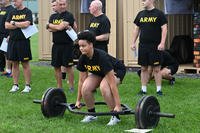If you are preparing for Special Operation programs that involve swimming and diving training, you will learn some or all of these strokes: the Combat Swimmer Stroke (CSS), elementary side stroke, Lead Arm-Trail Arm (LATA) and turtlebacking (with fins). All can be used when swimming with fins for long distances, as they are efficient and effective methods for swimming in open water and towing gear.
This is not your normal competitive swim stroke, though many special ops members come from a swimming background, as long as they learn to run and are durable enough to do load-bearing activities on land.
Regardless of your athletic history, you will need to practice swimming with fins if you are pursuing any of these programs: Navy SEAL, SWCC, EOD/diver, search-and-rescue (SAR) swimmer, USMC RECON/MARSOC, Air Force Special Warfare, Army Combat Dive School and Coast Guard rescue swimmer.
Here is a new favorite of the training group:
Swim a 500-Meter Warmup Without Fins
Learning to swim the testing distances for these programs as a warmup is recommended to all potential candidates. This alone may take a few months for a non-swimming athlete, so make sure you are putting in the time learning the stroke techniques you need and getting into swimming shape.
One of my favorite workouts is the 50/50 and the 100/100 workouts for mastering the fitness test to get accepted into these training programs. This new workout is similar to the 50/50 and 100/100 but with fins, as you will see below:
This workout section is done with fins, because nearly all follow-on training in the special ops pipelines will require swimming with fins.
Swim 100/50/50 with fins
The fin workout requires you to swim 100 meters of the most common stroke you will use with your training (usually the CSS or LATA). Then mix in some freestyle to use the arms and lungs a little more.
After that, catch your breath with a turtleback for 50 meters. Repeat that sequence 10-15 times. Each working set is 200 meters long and, when repeated 10-15 times, will total 2,000-3,000 meters.
You may need to build to that for a few months, as the lack of ankle mobility will be painful when you start.
Repeat 10-15 times.
- Swim 100 meters CSS or LATA at a steady pace
- Swim 50 meters freestyle fast
- Swim 50 meters turtleback to catch breath (without stopping). No rest: The turtleback is the recovery section.
- 5-10 minutes of treading (no hands) as a cooldown. This cooldown can be done with or without fins. You must learn both, as treading is involved in all special operations schools.
If you plan to attend any special ops program requiring diving and swimming, you will eventually do most of your swims with fins. You must practice for many months before attending any selection program to get through the training and graduate. This workout will help prepare you properly for future challenges of multiple swim strokes with fins (and scuba diving).
At least a few months out from attending these aquatic selection programs, start making your leg days end with swims with fins. Build up to 2,000-4,000 meters of swimming over time as you must master this ability with longer-distance swims.
Training just for the 500-yard swim for the entry physical screening test (PST) without fins is not enough. You have to put in the time wearing fins and getting your hips, legs and ankles ready for the work.
Stew Smith is a former Navy SEAL and fitness author certified as a Strength and Conditioning Specialist (CSCS) with the National Strength and Conditioning Association. Visit his Fitness eBook store if you're looking to start a workout program to create a healthy lifestyle. Send your fitness questions to stew@stewsmith.com.
Want to Learn More About Military Life?
Whether you're thinking of joining the military, looking for fitness and basic training tips, or keeping up with military life and benefits, Military.com has you covered. Subscribe to Military.com to have military news, updates and resources delivered directly to your inbox.


















